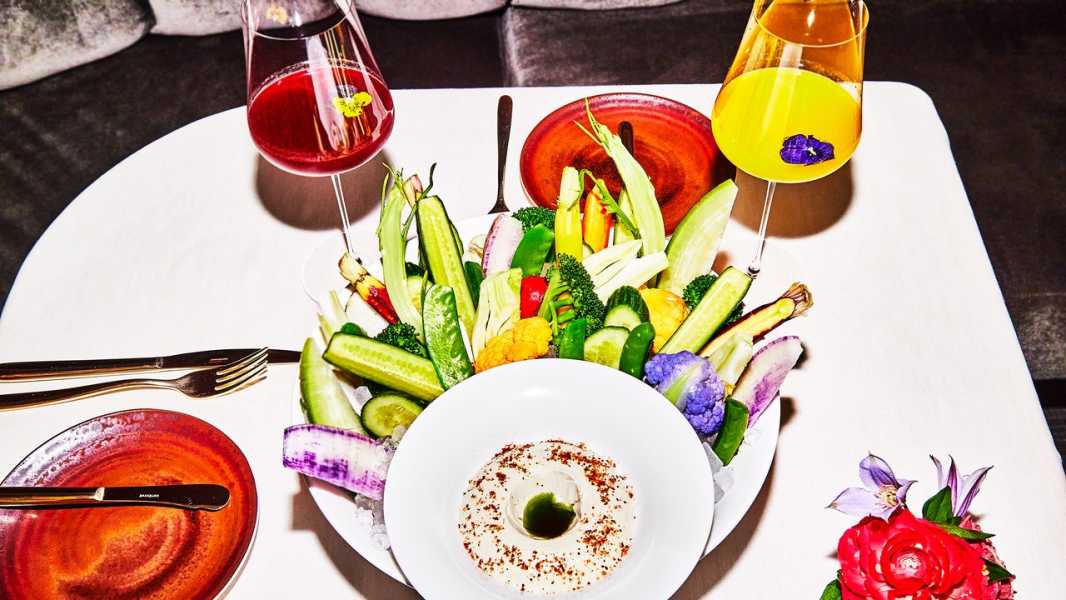
Save this storySave this storySave this storySave this storyYou’re reading the Food Scene newsletter, Helen Rosner’s guide to what, where, and how to eat. Sign up to receive it in your in-box.
In 2015, when the great glassy tower that reaches up to the vault of heaven on Park Avenue between Fifty-fifth and Fifty-sixth Streets was barely a hole in the ground, David W. Levinson, one of the principals of L&L Holding, the real-estate developer behind the building, boasted that the restaurant planned for the ground floor would be “a Four Seasons on steroids for the twenty-first century.” New York has always maintained a robust lunchtime ecosystem for the rich and the powerful; at the time of Levinson’s remarks, you could take your pick of scenes at Michael’s, Nello, Da Silvano, Fred’s. But the most rich and the most powerful spent their midday hours at the Four Seasons, three blocks away from where Levinson et al. were about to break ground. Its vast, masculine Philip Johnson interior, all marble and brass, leather and wood, evoked a material omnipotence. The thousands of slim brass chains draped across the enormous windows, minutely undulating, were an inverted Faraday cage: all the power was held inside.
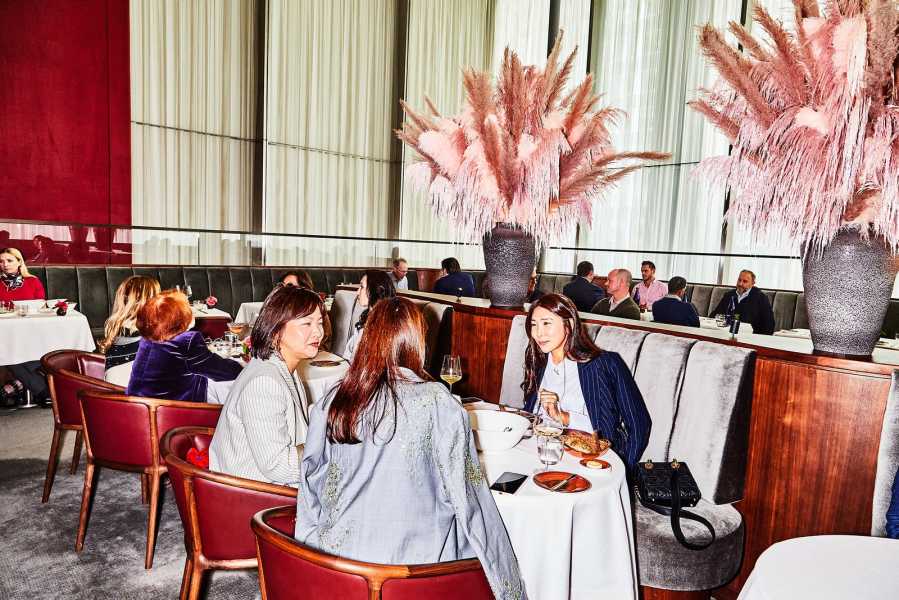
The dining-room décor—deep, bloody burgundy; leather upholstery; flamboyant floral arrangements—engages dutifully with the visual language of wealth.
Nearly a decade later, the Four Seasons is no more. Operations in its landmarked interior have been replaced by the Grill, which admirably upholds its tenets of service, exclusivity, and exorbitance, albeit with considerably better food. Levinson’s Park Avenue project, a forty-one-story office tower designed by Foster + Partners, is complete, and the restaurant on the northern side of the lobby is open for power lunching. Four Twenty Five, named somewhat unimaginatively after the building’s address, is operated by the mega-restaurateur Jean-Georges Vongerichten, and as promised it takes square aim at the upper echelons of the expense-account crowd, with a bar (at ground level) and a dining room (at the top of a medium-dramatic staircase) that engage dutifully with the visual language of wealth. The rooms are swathed in a deep, bloody burgundy; the seating is generous and leather-upholstered; there’s space enough between each table for the clandestine negotiation of business dealings or love affairs. The building’s enormous glass walls are veiled by a sheer fabric whose subtle horizontal stripes evoke the swagged metallic window treatments at that other dining room down the street while maintaining a discreet degree of plausible deniability.
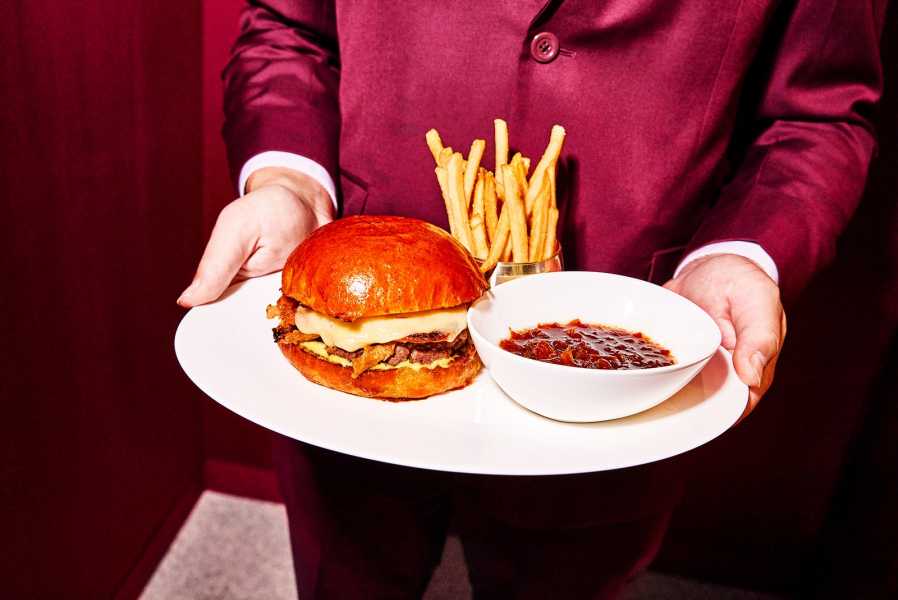
A burger for the midday crowd comes with a boat of French onion-ish jus for dipping.
Inset into the back wall of the dining room is a large pane of glass looking into the kitchen, whose non-stop action and stark, stainless-steel utility contrasts so dramatically with the womblike dining space that it feels almost like a living art installation. (Art is essential to a power restaurant; downstairs, the bartenders mix drinks beneath a twenty-four-foot-long Larry Poons.) The kitchen is overseen by Jonathan Benno, a blue-chip chef who for a long time was the culinary No. 1 at Per Se, and who did his best work in the years following, at Lincoln Ristorante, in Lincoln Center, and at his namesake Benno, where he displayed a tremendous aptitude for Italian cooking, particularly pasta and seafood. (Benno is now closed.) It’s curious to see a chef of Benno’s accomplishments hitch his wagon to an institution like Jean-Georges, Vongerichten’s restaurant group, where the only marquee name tends to be Vongerichten’s own. The Jean-Georges empire is so far-reaching, and has endured for so long, that it’s able to indulge in a little self-mythologizing: the bar menu at Four Twenty Five is an album of the restaurant group’s greatest hits, including a tuna encrusted with rice crackers from his downtown Perry St., an ur-dish of the Asian-fusion two-thousands, and petite bites of buttered black bread topped with uni that are a signature of Vongerichten’s eponymous flagship restaurant, which for a variety of reasons—not least its location, in a Trump building off Columbus Circle—is no longer considered very chic.
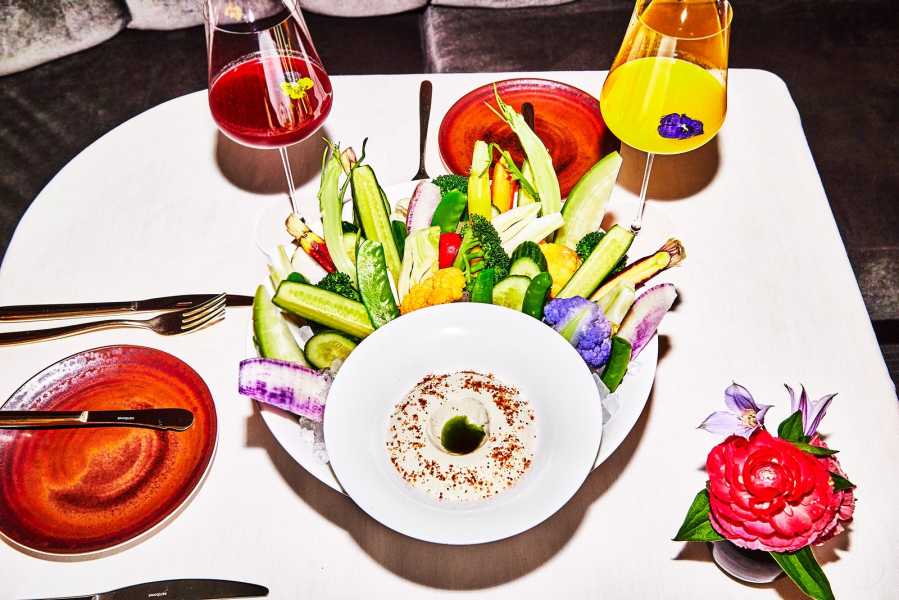
A sunflower-seed hummus with crudité caters to the wellness-minded.
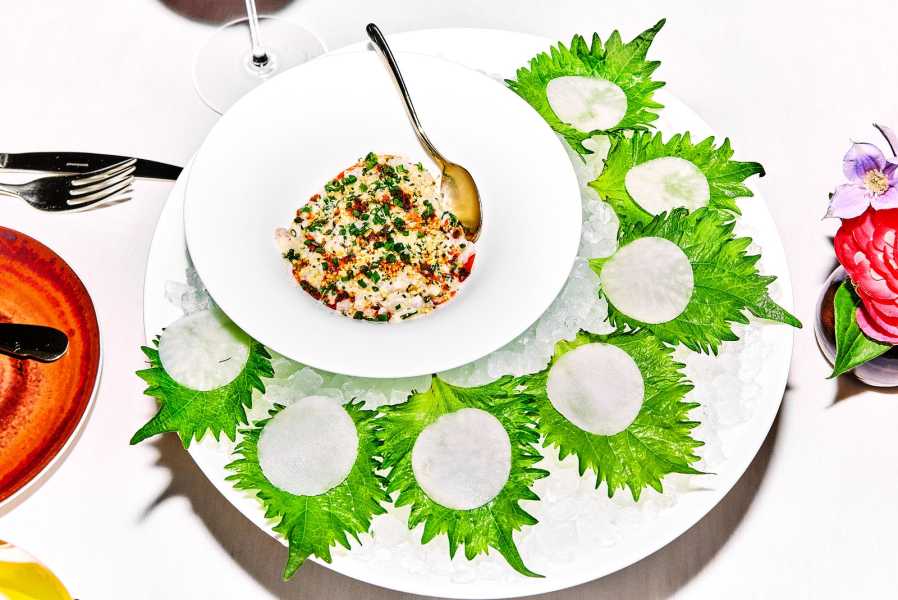
The celeriac francese gives the knobbly root vegetable an Italian American treatment.
Upstairs at Four Twenty Five, the tables are set with crisp linens, and if you order bottled water it will arrive with a slim brass coaster on which to rest the vessel between pours. Benno’s offerings are appropriately pitched to anticipate the desires of a clientele that wants to be pleased but not challenged. A section of the lunch menu called Simply Prepared features the lovely cuts of meat and fowl and fish from the regular entrées, minus the sides and most of the seasonings. But he gets to flex a little bit, too, as with a terrific tartare of finely minced fluke dressed with tahini, chili oil, and toasted rice powder, which is eaten scooped into shiso leaves, a take on Thai larb that’s both gentle and genteel. For the mid-century throwback crowd, there’s a seventy-eight-dollar veal chop (smallish and exquisite, but the accompanying dill-flecked spaetzle is the sleeper hit), which goes nicely with a bracing Martini. For the more modern power diner, attuned to the virtuous aesthetics of wellness, there’s a suite of blended juices served in slim-stemmed wine glasses, each garnished with a floating edible flower, and an airy hummus made of whipped sunflower seeds, served with a rainbow of crudités on a bed of ice. (The hummus is twenty-five dollars, which I suppose doesn’t matter, if you’re expensing it.) The food, over all, is best described as precise: ingredients of excellent quality, handled with expertise. If it’s never quite exciting, at least it’s always good. Spaghetti in a tangy, sunset-orange pepperoncini purée is overlaid with sea urchin, brine on brine; an appetizer of sesame-crusted sea scallops is velvet, with the tender mollusks draped in a subtly savory nori butter. The most rousing dish, to me, was an entrée of celeriac, the knobbly, turnip-like root vegetable, sliced into thick rounds and ingeniously prepared in the Italian American style known as francese: enrobed in a thin wash of egg, then doused in a sunshiney sauce of lemon juice and white wine.
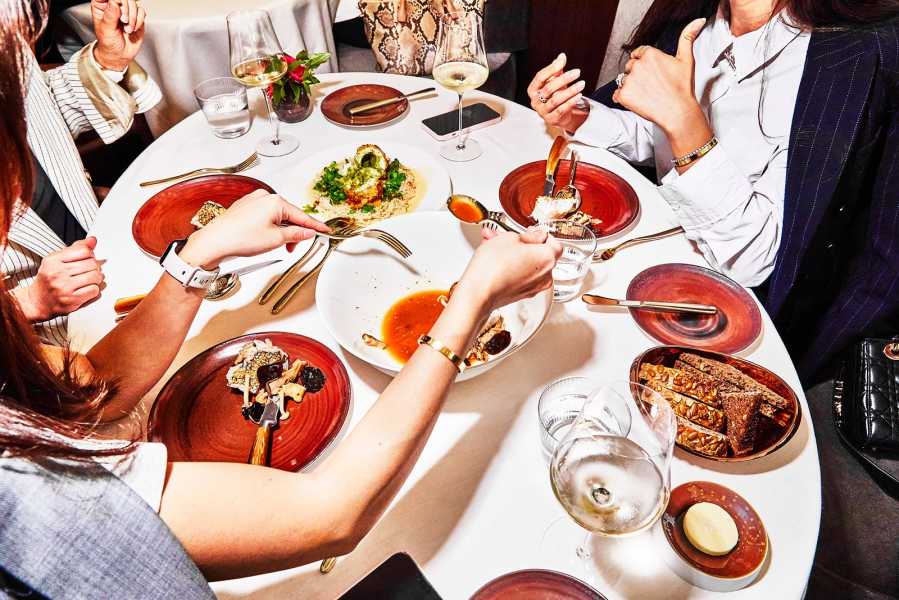
When it first opened, Four Twenty Five served dinner only, but it is a restaurant built to be lunched in.
Helen, Help Me!
E-mail your questions about dining, eating, and anything food-related, and Helen may respond in a future newsletter.
When it opened in December, despite its stated aspirations, Four Twenty Five served dinner only. In the evening, the room’s drama shifts: against a night sky, the room’s fixtures and linens take on a sultry edge, an effect enhanced by the enormous, feather-like floral arrangements that punctuate the room, and then undermined by the iPad wine lists, whose blazingly bright screens disrupt the restaurant’s soft, flattering lighting like a visual klaxon. This stretch of Park Avenue isn’t really a dinner destination; the brief traverse of the building’s lobby vestibule, on the way out of the restaurant, means that your final experience of dinner has all the elegance and romance of heading home after a late night at the office. This is a restaurant built to be lunched in: while the lunch and dinner menus are largely the same, the “Simply Prepared” section is exclusive to the midday crowd; a top-notch burger is served with fries (not too many) and a whole boat of a French onion-ish jus for dipping. The only downside of lunch is that you might be tempted to skip dessert, which would be a mistake: there’s a swoony rice pudding made with coconut cream and tropical fruits, and a note-perfect entremet of chocolate moelleux layered with a whirlwind of spiced creams and caramels and served with a quenelle of marzipan ice cream so silky and rich that it’ll make your toes curl. No one looks powerful taking a bite of ice cream, no matter how grand the room, or how lofty the skyscraper. That’s probably for the best. ♦
Sourse: newyorker.com






